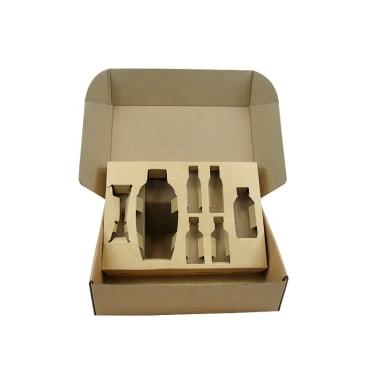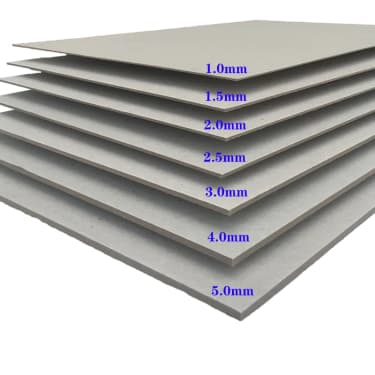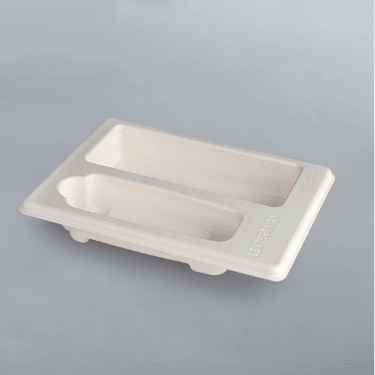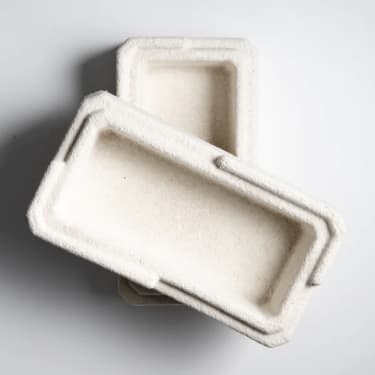Packaging Inserts
Packaging inserts refer to any items included in a product's packaging, except for the product itself. These items are placed inside the packaging box and serve multiple purposes. The packaging inserts can be classified into two categories based on their goals. One is the protection inserts, designed to protect the product, and the other is the informative inserts, which provide information about the product or promotion.
Types of packaging inserts
1. Protection inserts
Typically, they are referred to as box inserts, can be classified into eight types based on the distinct materials they use.
1.1 Paperboard inserts
Paperboard inserts are lightweight packaging materials, such as SBS, CCNB, CCK, UUK, Kraft paperboard, etc., primarily used for neatly organizing and presenting multiple items. They are not ideal for providing heavy-duty protection to fragile products due to their relatively soft and thin material. However, paperboard inserts can be an excellent choice for products that do not require heavy protection as they enhance their presentation. Moreover, paperboard inserts provide ample surface that can be used for printing product information, guidelines, brands, or colors, making their appearance appealing and elevating the unboxing experience.
Paperboard inserts are suitable for small, lightweight, delicate items, such as cosmetics, stationaries, confectionaries, chocolates, beauty products, etc.


1.2 Corrugated inserts
Corrugated inserts are commonly made from E-flute, F-flute, EB-flute, and B-flute. These materials are thicker and stiffer than paperboard, which makes them more durable against impacts. Corrugated inserts are designed to provide cushioning effects, essential for protecting fragile items during transportation. They help to separate objects from each other and prevent damage by absorbing the impacts of bumpy rides, keeping things intact. Additionally, corrugated inserts can be customized to match the aesthetics of paperboard inserts through a single-face laminate process, allowing for a visually appealing design and branding to amplify the brand's awareness.


1.3 Rigid chipboard inserts
Rigid chipboard inserts are a reliable and sturdy solution for shipping delicate items like ornaments or perfume bottles. They are crafted from reinforced cardboard without corrugation, which means they are solid and have less cushioning ability compared to corrugated cardboard. Therefore, better options to protect fragile products such as glassware may exist. However, they are great for keeping products separated and preventing them from colliding with each other during transit. These inserts are designed to be reused by customers to store other items in the future, making them a suitable choice in some cases.


1.4 Foam inserts
Foam inserts are an excellent option for safeguarding delicate items such as camera lenses, glass, and jewelry from scratches or damage. They are typically made from EPE, EVA, and PU foam. These foam inserts are usually die-cut to fit the shape of your products precisely. However, for small needs or to save costs, some businesses may use foam pads/sheets, which can be easily purchased online to protect their products, which don't require die-cutting. Additionally, these inserts are lightweight, which can help reduce shipping expenses.


1.5 Pulp packaging inserts
Pulp packaging inserts are an excellent choice for packaging fragile items as they provide high protection. These inserts are made from various recyclable and biodegradable materials such as paperboard and/or newsprint. An egg carton is a classic example of this type of packaging insert.
For many applications, molded pulp is less expensive than expanded polystyrene (EPS), vacuumed-formed PET, PVC, corrugation, and foams.
Pulp packaging is highly versatile and is available in various shapes and sizes. It can even support heavy items like wine bottles. When empty, these inserts can be stacked on top of each other, which helps save storage space.


1.6 Mushroom packaging
Mushroom packaging inserts are produced using mycelium and agricultural waste, resulting in durable and biodegradable materials that decompose in only six weeks. These inserts can be molded to fit the precise shape of products, similar to pulp packaging inserts.


1.7 Blister
Blister packaging is a popular technique that uses heat to form plastic materials such as PVC, PVDC, PCTFE, and COC. The plastic is molded to fit the product, providing a barrier against moisture and contaminants. However, it's worth noting that blisters are not recyclable. Although they are a lightweight packaging option, they cannot be easily recycled.


2. Informative inserts
Informative packaging inserts refer to prints that provide additional information about the product or promotion. They mainly come to the following types but are limited to.
2.1 Leaflets:
These are usually short and used to promote a new product or service.
2.2 Brochures:
These are more detailed than leaflets and provide comprehensive information about a product or service.
2.3 Catalogs:
Catalogs showcase a range of products or services and give customers a comprehensive view of what's on offer.
2.4 Cards:
These can be used for various purposes, such as providing product information, announcing new products, or offering discounts. They can also be used as a thank-you card to show gratitude.
2.5 Coupon or discount offers:
These inserts give customers discounts or special offers, encouraging them to buy a product or service.
2.6 Warranty guides:
These informative inserts inform customers about their warranty and what it covers. Warranty guides help customers understand their rights and what to do if something goes wrong with their purchase.
Advantages of Using Custom Cardboard Box Inserts for Product Protection
1. Extra Product Protection:
Custom packaging inserts are an excellent way to ensure that your products arrive at their destination in perfect condition. They are designed to protect and secure your products inside the shipping box. These inserts keep the items fixed, reducing the chance of collisions and absorbing the impact of bumpy transportation. By providing extra padding and cushioning, these inserts ensure that your products remain in excellent condition during transit. This is particularly important for fragile or delicate products requiring extra transportation care.
No matter how good or appealing your products are, your customers will undoubtedly be frustrated with your company and unhappy with the online purchasing experience if they arrive broken. Therefore, investing in custom packaging inserts is a wise choice to ensure that such complications never arise.
2. Fully Customizable:
Custom packaging inserts can be personalized to suit the specific needs of your business. They are entirely customizable, meaning companies can choose the size, shape, and design that best suits their products. Additionally, companies can print their logo, brand name, or brand colors on the inserts, allowing them to promote their brand and create brand awareness. With custom packaging inserts, you can be sure that your products are safely packaged while also promoting your brand.
3. Elevate the Unboxing Experience:
Custom packaging inserts can help you create a memorable unboxing experience for your customers. When products are presented neatly and aesthetically pleasing, customers are more likely to have a positive experience with the brand. This can lead to customer loyalty and repeat business. With custom packaging inserts, you can create a unique and visually appealing unboxing expertise that sets your brand apart from the competition.
4. Environmentally Friendly:
Custom packaging inserts are an environmentally friendly option for businesses. They can be made from recycled materials, reducing waste in landfills. This benefits the environment and can improve a company's reputation for being socially responsible. Using custom packaging inserts, you can demonstrate your commitment to sustainability and attract customers who value eco-friendly practices.
5. Cost-effective:
Custom packaging inserts are a cost-effective way of protecting your products during transportation. They reduce the risk of damage, which can result in costly returns, replacements, and unhappy customers. With custom packaging inserts, you can ensure that your products are safely delivered, saving you money in the long run.
Four factors worth considering when choosing the type of packaging inserts
When it comes to selecting appropriate packaging inserts, there are four key factors that you should consider.
1. Determine the level of protection that your product requires. Fragile items, for example, may need foam or bubble wrap inserts to avoid damage during transit. A paperboard insert may suffice for lightweight, delicate products that are not easily broken, such as cosmetics and small accessories.
2. Ensure that the sizes of both the packaging and the products are considered. The inserts should fit properly and securely to prevent any movement during shipping, which can result in damage.
3. Evaluate the cost of the inserts. Some materials may be more expensive, so weighing the benefits against the charges is essential.
4. Consider the environmental impact of the inserts. Opting for eco-friendly options, such as recycled or biodegradable materials, can reduce your carbon footprint and appeal to environmentally-conscious customers.
Considering these factors, you can choose the correct packaging inserts to ensure your products are safely and securely transported.
Three common paperboard or corrugated packaging insert structures
1. No-backing inserts
The term "no backing" means that the insert has no extended part to elevate the item away from the box’s bottom. This type of insert is designed to allow the products to sit directly on the base of the box, making it easier to fit more items per box.
2. With-backing inserts
The package inserts with backing have an extended part on one side, which can be folded easily to build an elevated pad. This feature benefits fragile items such as glassware, electronics, or other products that need additional protection. Using the with-backing insert, the delicate items are lifted above the base and kept in place, preventing them from moving during transportation, thus reducing the risk of damage.
3. Multiple-backings insets
The purpose of the multi-backing insert is to keep products organized and protected during transportation, just like regular inserts. However, it has an additional advantage. It features multiple backings with extended parts on the sides that lift the placed items over the base of the box. This provides extra cushioning to the box, ensuring all items are protected during transit.
How do custom cardboard box inserts work?
1. For the common three insert structures.
Customizing a package insert of the three types at CEF Box is a straightforward, four-step process.
Step 1: Dieline Drawing - First, create a precise dieline. Start by accurately measuring your products and recording their dimensions. Next, select the material you wish to use for your box. Remember, the thickness can vary among materials, impacting your insert's dimensions. Use our online dieline editor to enter these variables and produce an accurate dieline drawing. This process ensures your insert fits your product perfectly, providing a professional look.
Step 2: Graphic Design - Once you've finalized your dieline drawing, it's time to add some flair to graphic design. Our seasoned designers are ready and waiting to help create a unique, attention-grabbing design that embodies your brand.
Step 3: Configuring the Box - Get hands-on with our user-friendly online configurator. This tool lets you customize your box by selecting the size, material, coatings, finishes, and various printing options, making your insert unique to improve the unboxing experience.
Step 4: Place your Order - With the prior steps completed, it's time to place your order. Just sit back, relax, and let us do the rest. Our team will ensure your boxes are produced to the highest standards and arrive on time. With CEF Box, creating perfect, custom package inserts is a breeze.
2. For other specific structures
Structural design may be necessary to ensure packaging inserts fit your products properly. CEF Box offers structural services and is open to inquiries.
